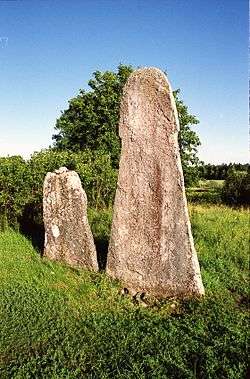Buttle, Gotland
Buttle is a populated area, a socken (not to be confused with parish), on the Swedish island of Gotland.[3] It comprises the same area as the administrative Buttle District, established on 1 January 2016.[4]
Buttle | |
|---|---|
 Änge picture stones in Buttle | |
 Buttle | |
| Coordinates: 57°24′9″N 18°31′47″E | |
| Country | Sweden |
| Province | Gotland |
| County | Gotland County |
| Municipality | Gotland Municipality |
| Area | |
| • Total | 31.07 km2 (12.00 sq mi) |
| Population (2014)[2] | |
| • Total | 90 |
| Time zone | UTC+1 (CET) |
| • Summer (DST) | UTC+2 (CEST) |
Geography
Buttle is situated in the central part of Gotland.[5] The medieval Buttle Church is located in the socken.[6] As of 2019, Buttle Church belongs to Vänge parish in Romaklosters pastorat, along with the churches in Vänge, Guldrupe, Sjonhem, Viklau and Halla.[7][8]
As of 2016, Buttle is best known for holding the record for both the lowest and highest temperature on Gotland. The highest temperature, 35.2 °C (95.4 °F), was recorded on 8 August 1975 and the lowest, −32.8 °C (−27.0 °F), on 9 February 1966.[9]
History
Two of the few picture stones left in their original places on Gotland, are located at Änge in Buttle. Most other stones have been used as building material in local churches or moved to various museums.[10] At 3.85 m (12.6 ft), the larger of the two is also the tallest known picture stone on the island.[11][12]
References
- Carlquist, Gunnar, ed. (1947–1955). "Buttle socken". Svensk Uppslagsbok (in Swedish) (2nd ed.). Malmö: Förlagshuset Norden.
- "Gotland i siffror 2015" [Gotland in numbers 2015]. www.gotland.se. Gotland Municipality. Retrieved 1 July 2016.
- The exact extent of the socken, now district, can be obtained by clicking on Kartinställningar and check the Socken box in the menu of this map from the Swedish National Heritage Board database.
- "Förordning om district" [Regulation of districts] (PDF). Ministry of Finance. 17 June 2015. Archived from the original (PDF) on 30 September 2018. Retrieved 1 July 2016.
- "Buttle". www.ne.se. Nationalencyklopedin. Retrieved 1 July 2016.
- Lagerlöf, Erland; Svahnström, Gunnar (1973). Gotlands kyrkor [Gotland's Churches] (in Swedish). Stockholm: Rabén & Sjögren. pp. 113–115. ISBN 91-29-41035-5. SELIBR 7232718.
- "Församlingar på Gotland". www.svenskakyrkan.se. Church of Sweden. Retrieved 12 January 2019.
- "Visby stifts indelning 2018". www.svenskakyrkan.se. Church of Sweden. Retrieved 12 January 2019.
- Vedin, Haldo. "Gotlands klimat" (PDF). www.smhi.se. Swedish Meteorological and Hydrological Institute. Archived from the original (PDF) on 13 August 2016. Retrieved 1 July 2016.
- Enderborg, Bernt. "Änges bildstenar". www.guteinfo.com. Guteinfo. Retrieved 1 July 2016.
- "RAÄ-nummer Buttle 42:1". www.raa.se. Swedish National Heritage Board. Retrieved 1 July 2016.
- Henriksson, Greta (11 January 2015). "Fornminnen Buttle". www.gotland.se. Gotland Municipality. Retrieved 1 July 2016.
External links

- Objects from Buttle at the Digital Museum by Nordic Museum
